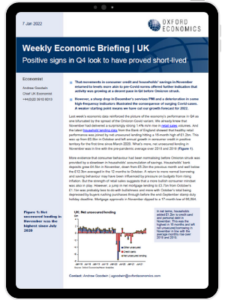Positive signs for UK economy in Q4 look to have proved short-lived

That movements in consumer credit and households’ savings in November
returned to levels more akin to pre-Covid norms offered further indication that activity was growing at a decent pace in Q4 before Omicron struck.
However, a sharp drop in December’s services PMI and a deterioration in some high-frequency indicators illustrated the consequence of surging Covid cases.
What you will learn:
- More evidence that consumer behaviour had been normalising before Omicron struck was provided by a slowdown in households’ accumulation of savings.
- Unfortunately, evidence of stronger activity in November looks to have been usurped by the consequences of the rapid spread of the Omicron Covid variant, a rise in the number of people isolating and increased consumer hesitancy.
- Moreover, the latest high-frequency indicators added to the evidence that the services sector has been hard hit by Omicron. CHAPS data on credit and debit card spending showed social spending in December averaged just under 90% of the February 2020 level.
Tags:
Related research

Post
Tariff Sector Vulnerability Index
Electronics, electricals, motor vehicles, pharmaceuticals and machinery are most exposed globally to US-imposed tariffs.
Find Out More
Post
Silver lining for China’s residential real estate sector
Residential real estate commencements (floor area) are expected to pick up over 2025. However, activity will remain at structurally lower levels, with Chinese authorities expected to maintain their goal to clamp down on speculative demand.
Find Out More